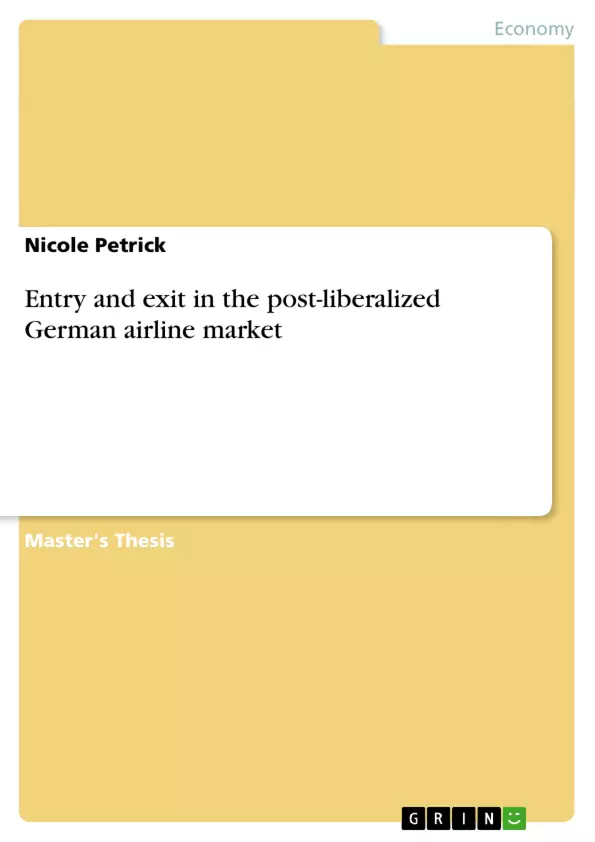This paper examines actual entry and exit dynamics in the German airline market in light of the European liberalization process. For this purpose, flight schedules data was used to derive entry and exit statistics for a set of chosen inner-German routes over a period of thirteen years. Data was analysed in cross-sectional and longitudinal manner while identifying different entry waves and examining incumbent behaviour with respect to entry deterrence strategies. Furthermore, the market’s concentration and structure was tracked to allow a conclusion with respect to the market’s contestability after liberalization. The results suggest the existence of remaining structural barriers to entry and depict a rather unsatisfactory overall state of the post liberalized market.
Inhaltsverzeichnis (Table of Contents)
- List of Illustrations
- Abbreviations
- Acknowledgements
- INTRODUCTION
- THE LIBERALIZATION PROCESS OF EUROPE'S SKIES
- Pre-Liberalization Status Quo
- Liberalization of Intra-European Air Transport
- The three Liberalization Packages
- Cabotage Rights
- The Single European Sky Initiative 2004
- Liberalization of International Air Transport
- Liberalization Review
- THEORY
- What do we know about entry?
- Entry deterrence and dynamic competition
- A model of limit capacity
- Excess capacity as prospect for collusion
- A four-stage game of airline market entry
- Airline capacity utilization
- THE GERMAN AIRLINE MARKET
- Infrastructure
- Airports
- Slots, slot pools and slot allocation
- Demand for air travel
- Supply of air travel
- Ground transport
- Railway system
- Road network
- The short-haul problem
- Modes of transport compared
- Infrastructure
- ANALYSIS OF ENTRY AND EXIT
- Purpose
- Data
- Data construction
- Strengths and weaknesses of the data set
- Methodology
- Entry, exit and welfare effects
- Entry and exit over time
- The 1996 entry wave
- The 2004 entry wave
- Airlines 1993-2006
- Entry, exit and market concentration
- Entry, exit and incumbent behaviour
- Entry, exit and prices
- The German Airline Market in 2006
- Route network
- Market shares
- Brand competition
- Summary of Results
- IMPEDIMENTS TO COMPETITION
- Barriers to entry
- Strategic barriers to entry
- Structural barriers to entry
- Alliances an economic necessity?
- Barriers to entry
- SUMMARY
Zielsetzung und Themenschwerpunkte (Objectives and Key Themes)
This master's thesis investigates the entry and exit dynamics in the German airline market in the context of European liberalization. The study aims to analyze the impact of liberalization on market structure and competition, particularly focusing on the presence of barriers to entry and the strategies employed by incumbent airlines.
- The impact of European liberalization on the German airline market
- Analysis of entry and exit patterns in the German airline market
- Identification of barriers to entry, including both strategic and structural factors
- Examination of incumbent airline behavior and entry deterrence strategies
- Assessment of the market's contestability and the overall state of competition after liberalization
Zusammenfassung der Kapitel (Chapter Summaries)
- Chapter 1: Introduction: This chapter provides a brief overview of the thesis, outlining its purpose, scope, and methodology. It also presents the research questions and hypotheses that will be investigated.
- Chapter 2: The Liberalization Process of Europe's Skies: This chapter examines the historical context of airline market liberalization in Europe. It outlines the pre-liberalization status quo and the major liberalization packages implemented, including the Single European Sky Initiative.
- Chapter 3: Theory: This chapter explores relevant theoretical concepts related to market entry, exit, and competition. It delves into models of entry deterrence and dynamic competition, examining factors that influence the entry and exit decisions of firms.
- Chapter 4: The German Airline Market: This chapter provides a comprehensive analysis of the German airline market, focusing on its infrastructure, demand, supply, and ground transportation connections. It also highlights the specific challenges posed by the short-haul problem in the German context.
- Chapter 5: Analysis of Entry and Exit: This chapter presents the empirical analysis of entry and exit patterns in the German airline market. It uses flight schedule data to track entry and exit activity over time and identify various entry waves. It also explores the relationship between entry and exit, market concentration, incumbent behavior, and price changes.
- Chapter 6: Impediments to Competition: This chapter discusses the factors that hinder competition in the German airline market, focusing on both strategic and structural barriers to entry. It also examines the role of alliances in the industry.
Schlüsselwörter (Keywords)
The main keywords and focus topics of the thesis encompass airline market liberalization, entry and exit dynamics, competitive analysis, barriers to entry, market concentration, incumbent behavior, and the German airline market.
- Quote paper
- Nicole Petrick (Author), 2007, Entry and exit in the post-liberalized German airline market, Munich, GRIN Verlag, https://www.grin.com/document/78738



